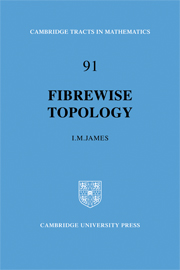V - Miscellaneous topics
Published online by Cambridge University Press: 05 November 2011
Summary
Fibre bundles
This is not the place for a lengthy discussion of the theory of fibre bundles; after all, a full-scale treatment can be found in several of the well-known textbooks. It is, however, necessary to give a brief sketch so as to be in a position to show how the material presented earlier in this volume fits into th1694e theory.
There are two main ways to approach the theory of fibre bundles. The first may be called the Whitney approach, since it goes back to the original paper of Whitney on ‘sphere-spaces’. This fits in well with the requirements of differential topology. The other approach is due to H. Cartan and fits in well with the theory of topological transformation groups. Students of the subject need to understand both approaches and the relation between them.
As before we work over a topological base space B. In the crudest form of the definition a fibre bundle over B is a fibrewise topological space X which is locally trivial, in the sense of §1. Specifically there exists an open covering {Bj} of B such that the restriction Xj = XBj of X to Bj is trivial over Bj for each index j. Thus for each j we have a fibrewise topological equivalence ϕj: Xj → Bj × Tj for some topological T. To simplify matters we assume that Tj is independent of j, as can always be arranged when B is connected. Thus ϕ: Xj → Bj × T for some topological T, called the fibre. Note that ϕjϕk–1 determines a fibrewise topological equivalence of (Bj∩Bk) × T with itself for each pair of indices j, k.
Information
- Type
- Chapter
- Information
- Fibrewise Topology , pp. 176 - 190Publisher: Cambridge University PressPrint publication year: 1989
